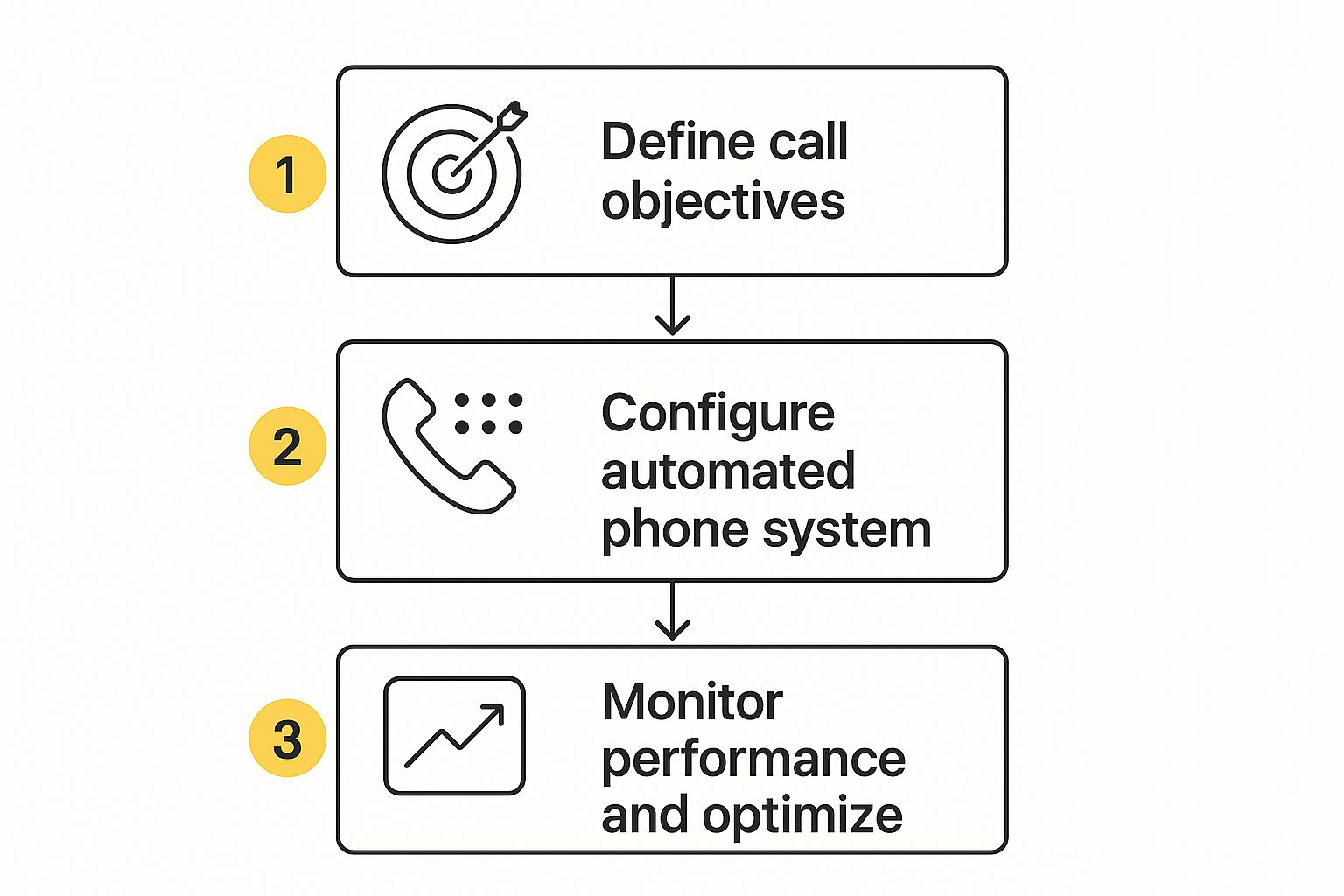Think about your business phone line for a moment. When it gets busy, it's like a single-lane road hitting peak hour traffic. Everything grinds to a halt, calls get missed, and customers get frustrated. Automated business calls are the solution that turns that congested road into a multi-lane smart highway, ensuring every interaction flows smoothly, 24/7.
This isn't just about having a glorified answering machine. It's about using smart, AI-powered systems to handle your incoming and outgoing calls without needing a human glued to the phone. It effectively transforms a standard phone line from a potential bottleneck into a powerful tool for growth.
What Are Automated Phone Calls For Business?
Let's be honest, missed calls are a massive problem, especially for small to medium businesses here in Australia. It’s a chronic issue that quietly bleeds revenue.
In fact, studies show that a staggering 22% to 62% of calls to SMEs go unanswered. This adds up to an estimated loss of over $8 billion every year, simply because 85% of people whose call isn't answered the first time just won't bother calling back. If you want to dive deeper into these numbers, you can learn more about how missed calls impact Australian businesses.
This is where automated call systems step in, making sure you never miss an opportunity again.

From Basic IVR To Smart AI Agents
You've probably experienced early automated systems firsthand. They were the clunky Interactive Voice Response (IVR) menus famous for the endless loop of "press one for sales, press two for support." While they served a purpose, these systems were rigid and often a dead end for customers whose problems didn't fit neatly into a numbered option.
Thankfully, we've come a long way. Today’s automated business call systems are powered by sophisticated Artificial Intelligence (AI) and can do so much more:
- Understand natural speech, so customers can just say what they need instead of navigating a confusing menu.
- Route calls intelligently based on what the caller is actually asking for.
- Handle complex tasks like booking appointments, taking payments, and answering detailed questions on the spot.
This evolution represents a huge leap from a one-way command system to a genuine two-way conversational tool. It means businesses can offer instant, helpful service around the clock, without having to constantly hire more people.
The real power of modern automation isn't just about answering calls. It’s about building a responsive, reliable communication channel that captures every single lead and improves the customer experience from the very first hello.
To really see the difference, let’s compare the old way of doing things with what’s possible now. The table below breaks down the limitations of a traditional phone line versus the clear advantages of an automated system. It's easy to see why so many businesses are making the switch.
Traditional vs Automated Business Call Handling
| Feature | Traditional Phone Line | Automated Call System |
|---|---|---|
| Availability | Limited to business hours and staff presence | 24/7, 365 days a year |
| Call Capacity | Handles one call at a time per line | Manages hundreds of simultaneous calls |
| Customer Experience | Long wait times and potential for missed calls | Instant response and no busy signals |
| Scalability | Requires hiring more staff to handle growth | Scales instantly to meet demand without overheads |
| Data Collection | Manual note-taking and inconsistent data entry | Automatic logging of call details and insights |
The contrast is stark. An automated system not only solves the immediate problem of missed calls but also provides a scalable foundation for better service and smarter operations as your business grows.
Right, so you understand the tech behind automated calls. But what does it actually do for your business? This is where the magic happens. We’re not just talking about answering more calls; we’re talking about a fundamental shift in how your business operates, making it more profitable and customer-friendly. The ripple effects are felt everywhere, from your front desk right down to your bottom line.
When you step away from doing everything by hand, you start to see some serious advantages. Let’s break down how these systems deliver real-world results.
Slashing Operational Costs
The first and most obvious win is a big drop in your operational costs. Think about it: handling calls manually means paying for staff, training them, and managing them. All those repetitive jobs—answering the same old questions, routing calls, taking basic messages—chew up countless hours that your team could be spending on something far more valuable.
An automated phone system works 24/7. It doesn’t need a lunch break, public holidays, or overtime pay. It effectively takes your team off switchboard duty, freeing them up to focus on the complex, money-making tasks that really need a human brain.
This isn't just a hunch; it's a proven financial strategy. In fact, over 70% of Australian companies now see automation as a key part of their game plan. Businesses that nail this transition can cut their operational costs by 25% to 45% and often see their profit margins jump by an average of 20% in just two years. You can read more about these strategic findings for Australian businesses.
Boosting Efficiency and Team Focus
Efficiency isn't just about speed; it's about focus. When your team is constantly being pulled away from their work by a ringing phone, their concentration is shot. Productivity takes a nosedive. They spend their day playing telephone operator instead of solving customer problems or closing sales.
Automated phone calls for business act as your smart front line, fielding the flood of simple, repetitive enquiries. This means only the important, complex stuff gets through to a real person. Not only does this make your team massively more effective, but it also lifts morale because they get to do more interesting and rewarding work.
Enhancing Customer Experience and Scaling with Ease
In this market, a bad customer experience is a deal-breaker. Making people wait on hold or sending them to a full voicemail is a surefire way to lose their business. Automation tackles this problem head-on.
- Instant Responses: Callers get an answer every single time. No more busy signals or voicemail purgatory.
- 24/7 Availability: Your business is essentially always "open," ready to help customers or capture new leads, even at 10 PM on a Sunday.
- Effortless Scalability: Got a big marketing campaign coming up? Or just an unexpectedly busy Tuesday? The system handles a sudden spike in calls without even breaking a sweat. You can scale up or down instantly, without the headache and cost of hiring and training more staff.
How Businesses Are Using Automated Calls Today

The theory behind automated calls sounds good, but their real power comes alive when you see them in action. Across Australia, savvy businesses are ditching manual phone handling and using automation to solve genuine problems, boost revenue, and get a leg up on the competition. This isn't some futuristic fantasy; these are practical strategies being used right now.
Think about a busy medical clinic. Their front desk staff used to sink hours every day calling patients just to confirm appointments. Now, an automated system sends out friendly reminder calls, letting patients confirm or reschedule with a quick voice command or by pressing a button. This one change slashes the number of costly no-shows and frees up the reception team to focus on the patients right there in the clinic.
Driving Sales and Qualifying Leads
For any sales-focused business, speed is the name of the game. A sales team can't afford to get bogged down chasing cold leads or dialling hundreds of numbers by hand. This is where automated phone calls for business deliver a massive competitive edge.
An AI-powered system can chew through a list of new leads overnight, asking the first round of qualifying questions. It sorts out the genuinely interested prospects and pops a call-back directly into a human sales agent's calendar for the next morning. Your team walks in to find a list of warm, pre-vetted leads just waiting to be closed.
The goal here isn't to replace your salespeople; it's to give them superpowers. Automation takes care of the repetitive, low-value grunt work of prospecting, so your skilled agents can pour their energy into high-stakes conversations and actually building relationships.
Improving Customer Service and Feedback
Beyond just making sales, automation is completely changing how businesses support their existing customers. From tradies to subscription-based companies, the uses are incredibly versatile.
For instance, a home services company like a plumber or electrician can use automated calls to:
- Dispatch Technicians: Instantly alert the on-call technician about an emergency job, sending all the critical details without a single delay.
- Schedule Appointments: Let customers book non-urgent service calls 24/7, which integrates straight into the company's scheduling software.
- Gather Feedback: Send out a post-service survey call to get immediate feedback on the customer’s experience, which is brilliant for maintaining high service standards.
Another really powerful use is for managing those slightly awkward communications. A subscription service can use a professional, automated voice to handle payment reminders. This takes the personal awkwardness out of collection calls, keeps the customer relationship positive, and helps ensure you’re sticking to any financial communication rules.
These examples show how a well-set-up system does a lot more than just answer the phone. If you're wondering how to get this working for your own business, you can learn how to automate phone calls and start streamlining your workflow. Each of these uses offers a real strategic advantage, turning a standard phone line into a proactive tool for growth and efficiency.
How AI Is Making Phone Systems Smarter
So, what really separates a basic robocall from a truly intelligent communication tool? The answer is Artificial Intelligence. AI is the engine that transforms standard automated phone calls into dynamic, responsive systems that feel less like a machine and more like a genuinely helpful assistant.
It’s the difference between a frustrating, dead-end phone menu and a smart, productive conversation. We've all been there, stuck in that endless loop of "press one for sales, press two for support." Modern systems, powered by AI, are leaving that clunky experience in the dust by understanding and adapting to what a caller actually needs in real time.
From Rigid Menus to Real Conversations
The biggest game-changer here is Natural Language Processing (NLP). Think of it as the system's ears and brain. It allows the system to understand what a customer is saying in their own words, just like a person would. So, instead of just listening for specific keywords, NLP can grasp the real meaning behind a phrase like, "I need to check on my order from last Tuesday," and know exactly what to do with that information.
Then you have another powerful AI tool: sentiment analysis. This is where the system gets really clever. It can gauge the caller's emotional state by analysing their tone of voice and word choice. If it detects frustration or urgency, it can immediately flag the call for a human agent, making sure critical issues get the attention they deserve.
At its core, AI in phone systems is about moving beyond simple button-pressing and into the world of intelligent assistance. It turns every call into a source of valuable data and a chance to deliver a genuinely helpful, personalised experience.
This intelligence also completely changes how calls are routed. Instead of just dumping a call into a general department queue, smart routing uses what it's learned about the caller's needs to send them to the perfect person for the job. For instance, a new lead with complex questions about your products can be sent straight to your most experienced sales specialist, not a generic inbox.
How AI Unlocks New Efficiencies
AI-powered automated calling systems can now handle a huge volume of the repetitive, administrative tasks that used to eat up your team's day. This shift has been a massive boost for both efficiency and customer satisfaction. It allows businesses to move beyond the limits of a single phone line and adopt more scalable solutions like 1300 numbers that can manage multiple callers at once. You can discover more about how AI and automation are transforming business right here in Australia.
Here’s where you’ll see a tangible difference with AI-driven features:
- Intelligent Prioritisation: The system can spot high-value callers (like a hot new lead) or urgent support issues and bump them straight to the front of the queue.
- Data-Driven Insights: Every interaction is analysed, giving you a goldmine of insights into common customer questions, peak call times, and overall satisfaction.
- Proactive Engagement: AI can trigger automated follow-up calls for things like appointment reminders or feedback surveys, freeing your team from having to make those calls manually.
Ultimately, bringing AI into your phone system turns a reactive tool into a proactive one. It doesn’t just answer calls anymore; it understands them, learns from them, and helps you serve your customers on a whole new level.
How to Implement an Automated Call System
Bringing an automated phone system into your business might sound like a huge technical headache, but it’s actually more straightforward than you might think. When you break the process down into a few manageable steps, even sophisticated automation becomes achievable for any business, no matter the size. The real secret is starting with a clear plan before you even think about the technology.
Your first move? Figure out your main goal. What specific problem are you really trying to solve with this? Nailing this down from the start will guide every single decision you make later, from picking the right provider to designing how your calls will flow.
Define Your Core Objectives
Before you even glance at any software options, you need to ask yourself what you truly need the system to do. Having a clear purpose stops you from getting sidetracked by flashy features you’ll never actually use.
Some of the most common goals we see for setting up automated business calls include:
- Capturing Missed Calls: Making sure every potential lead or customer who rings after hours or when you're flat-out gets a response.
- Automating Reminders: Slashing the number of no-shows for appointments, consultations, or service calls. It's a simple fix that saves a lot of wasted time.
- Qualifying New Leads: Automatically screening inbound calls to pass only the most promising prospects to your sales team. This lets your team focus on closing deals, not filtering calls.
- Gathering Customer Feedback: Systematically collecting feedback after a service through automated surveys to help you improve what you offer.
This simple chart here gives you a bird's-eye view of the whole journey, from initial planning right through to optimisation.

As you can see, success really starts with setting clear goals. After that, it's all about careful setup and keeping an eye on things to make sure it's working for you.
Design an Intuitive Call Flow
Once your goal is crystal clear, the next step is to map out the ideal journey for your customers. This call flow is basically a blueprint for how the system will interact with anyone who calls you. Think of it as creating a smart, helpful path for your customers to follow.
For instance, a real estate agency's call flow might automatically route callers asking about a specific property to a pre-recorded message with all the details, while anyone asking to speak to an agent gets transferred directly. The aim is to make the whole experience feel natural and helpful, not robotic and frustrating. Your call management software should make this dead simple to set up. For more ideas on how different platforms handle this, you can check out our guide on choosing the right call management software.
A clean, easy-to-use dashboard is your best friend here. It makes it simple to see which calls need your attention and helps you streamline your follow-up process so nothing falls through the cracks.
Launch, Test, and Optimise
Alright, it’s time to bring your system to life. The first thing you need to do is record professional, clear voice prompts—this is absolutely crucial for making a good first impression. If you can, avoid using a robotic text-to-speech voice; a real human voice builds much more trust and rapport.
Critical Tip: Before you go fully live, test the system like crazy. Call in from different phone numbers, try every single menu option, and make sure all the call routing works exactly as you planned. Launching a system with flaws can seriously frustrate customers and completely defeat the purpose.
Once you’ve launched, the job isn't over. Not by a long shot. Use the analytics your system provides to monitor its performance. Keep an eye on metrics like call duration, how many people hang up (abandonment rates), and which menu options get used the most. This data is pure gold—it tells you exactly what’s working and where you can tweak things for an even better customer experience.
Common Questions About Automated Phone Systems

Diving into any new technology can feel like a big step, and it’s only natural to have a few questions. When it comes to automated phone calls for business, a lot of owners share the same worries. We’ve pulled together the most common questions to give you clear, straight-up answers.
Our goal is to pull back the curtain on this stuff. We want to show you how it can be a practical, powerful tool for your business, not some complex headache. Let's tackle some of those key uncertainties head-on.
Will My Customers Hate Talking to a Robot?
This is easily the biggest concern for business owners, and it’s a fair one. No one enjoys getting stuck in a frustrating, robotic phone menu that goes nowhere. But here's the thing: modern AI-powered systems are a world away from those clunky "press one for this, press two for that" menus of the past.
Today’s smart systems use conversational AI, which means they can actually understand natural language. Customers can just say what they need in their own words, making the whole experience feel much smoother and more human. In fact, one study found that 69% of consumers are happy to use AI tools if it gets them a faster answer. The secret is to design a call flow that’s genuinely helpful, not a roadblock, and always gives people an easy out to speak to a real person if they need to.
Is This Only for Big Companies with Call Centres?
Not at all. Truth be told, it's often the small and medium-sized businesses that get the biggest bang for their buck from call automation. Think about it—a solo tradie, a small real estate agency, or a local mortgage broker can't afford to miss calls, but they probably can't afford a full-time receptionist either.
Automated phone systems really level the playing field. They give smaller operators the kind of 24/7 responsiveness and professional front that used to be only for the big corporations, all for a tiny fraction of the cost.
These systems are built to scale with you. You can start with a simple setup to catch those after-hours calls and then add more features as your business grows. You only ever pay for what you actually use.
Is It Difficult and Expensive to Set Up?
Getting started with automated calls for your business is a lot more straightforward than you might think. Most modern platforms are designed to be user-friendly, with simple dashboards that let you build your own call flows without needing a degree in computer science.
As for the cost, the return on your investment often kicks in straight away. Just think about it:
- Reduced Overheads: You save on the cost of hiring someone just to manage the phones.
- Increased Revenue: You stop losing those valuable leads that come from missed calls.
- Improved Efficiency: Your team gets more time to focus on the core tasks that actually make money.
Many providers offer flexible, affordable monthly plans. When you compare that small cost to the lost revenue from just one or two missed opportunities a month, it's a no-brainer.
Ready to stop missing calls and start growing your business? OnSilent provides an intelligent, easy-to-use solution that manages your calls, captures every lead, and saves you hours every week. Discover how OnSilent can transform your business communications today.

